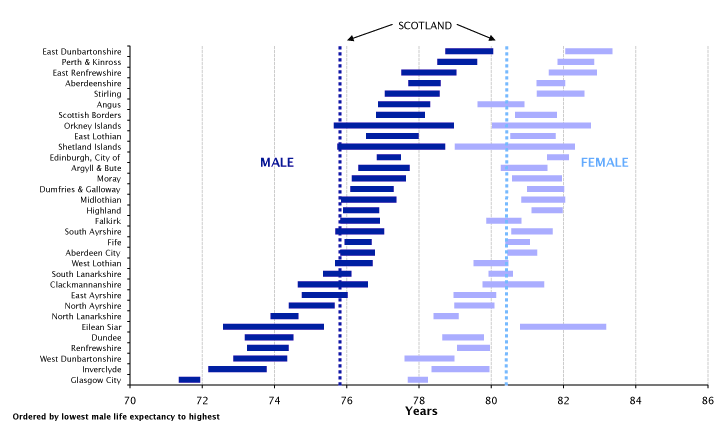
4.1.1 Table 1 shows life expectancy at birth and at five-year intervals in Scotland and Council areas for 2008-2010. Table 6 and Table 7 show the life expectancy at birth and rank for Council areas, along with comparisons with five and ten years ago. In Figure 3 life expectancy at birth in 2008-2010 is shown with the associated 95 per cent confidence intervals for each of the Council areas. Life expectancy for an area can be said to be significantly different from another area if the 95 per cent confidence intervals do not overlap.
Figure 3 Life expectancy at birth, 95% confidence intervals for Council areas,2008- 2010 (Males and Females)

4.1.2 For males, the Council area with the lowest life expectancy was Glasgow City (71.6 years) and the Council area with the highest life expectancy was East Dunbartonshire (79.4 years), a difference of 7.8 years between highest and lowest.
4.1.3 For females, Glasgow City had the lowest life expectancy (78.0 years) and the highest life expectancy was in East Dunbartonshire (82.7 years), a difference of 4.7 years.
4.2.1 Table 2 shows life expectancy at birth and five-year intervals in Scotland and NHS Board areas for 2008-2010. Table 6 and Table 7 show the life expectancy at birth and rank for NHS Board areas, along with comparisons with five and ten years ago. Figure 4 shows life expectancy at birth in 2008-2010, along with 95 per cent confidence intervals for each of the NHS Board areas.
Figure 4 Life expectancy at birth, 95% confidence intervals for NHS Board areas, 2008-2010 (Males and Females)
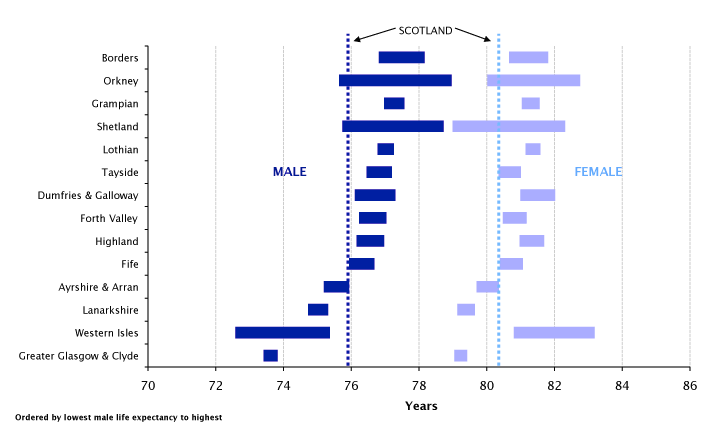
4.2.2 The NHS Board area with the highest life expectancy was Borders for males (77.5 years) and Western Isles for females (82.0 years).
4.2.3 The Greater Glasgow & Clyde NHS Board area was the area with the lowest life expectancy, both for males (73.6 years) and females (79.2 years).
4.3 Community Health Partnership areas
4.3.1 Table 3 shows life expectancy at birth and five-year intervals in Scotland and Community Health Partnership (CHP) areas for 2008-2010. Table 8 and Table 9 show the life expectancy at birth and rank for CHP areas, along with comparisons with five and ten years ago. Figure 5 shows life expectancy at birth along with the 95 per cent confidence intervals for each CHP.
Figure 5 Life Expectancy at birth, 95% confidence intervals for Scottish Community Health Partnership Areas, 2008-2010 (Males and Females)
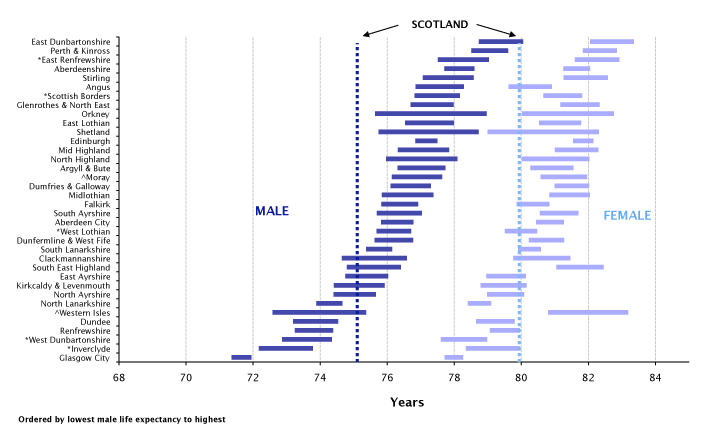
* Known as a Community Health and Care Partnership.
^ Known as a Community Health and Social Care partnership.
4.3.2 The CHP with the highest male life expectancy at birth was East Dunbartonshire where males could expect to live for 79.4 years. This is 7.7 years longer than in Glasgow City, where male life expectancy was lowest at 71.7 years.
4.3.3 The CHP with the highest life expectancy at birth for females was also East Dunbartonshire, where females could expect to live 82.7 years, 4.7 years longer than in Glasgow City, the CHP with the lowest life expectancy (78.0 years).
4.3.4 The largest gap between male and female life expectancy at birth was in Western Isles Community Health and Social Care Partnership, where males (82.0 years) could expect to live 8.0 years longer than females (74.0 years).
4.4 Urban Rural 6-fold classification
4.4.1 Table 4 shows life expectancy at birth and five-year intervals in Scotland for each area in the 2009 Urban/Rural 6-fold classification. Figure 6 shows life expectancy at birth along with 95 per cent confidence intervals for these areas.
Figure 6 Life expectancy at birth, 95% confidence intervals for Urban/Rural classification, 2008-2010 (Males and Females)
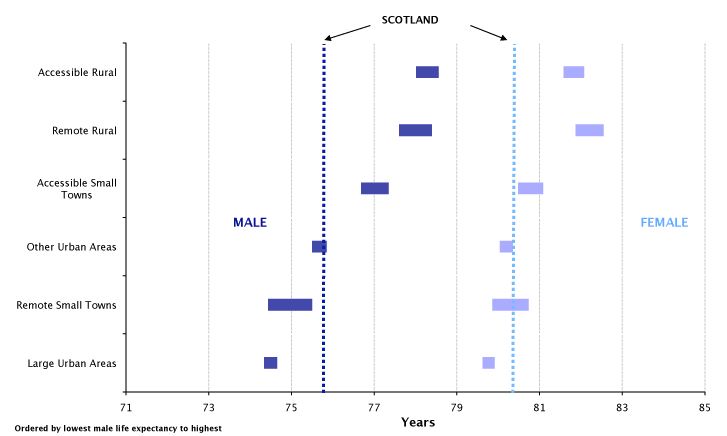
4.4.2 Male life expectancy at birth is highest in Accessible Rural areas at 78.3 years, 3.8 years longer than in Large Urban areas, where male life expectancy is the lowest (74.5 years).
4.4.3 The gap between highest and lowest female life expectancy at birth was not as wide. It was highest in Remote Rural areas (82.2 years) and lowest in Large Urban areas (79.8 years), a gap of 2.4 years.
4.4.4 The biggest gap between male and female life expectancy is in Large Urban areas and in Remote Small Towns. In both these areas, females can expect to live 5.3 years longer than males.
4.4.5 Males and females in Remote Rural areas, Accessible Rural areas and Accessible Small Towns all have a higher life expectancy than the average figure for Scotland.
4.5 Scottish Index of Multiple Deprivation 2009 decile
4.5.1 Life expectancy at birth and at five-year intervals for each deprivation decile[2] is shown in Table 5. Figure 7 shows 95 per cent confidence intervals for male and female life expectancy at birth in each decile. As explained in Section 8.4, the Scottish Index of Multiple Deprivation (SIMD) measures deprivation and not affluence, therefore the life expectancy figures presented in this publication should not be translated as ‘life expectancy of the rich versus that of the poor’.
Figure 7 Life expectancy at birth, 95% confidence intervals for Scottish Index of Multiple Deprivation 2009 Deciles, 2008-2010 (Males and Females)
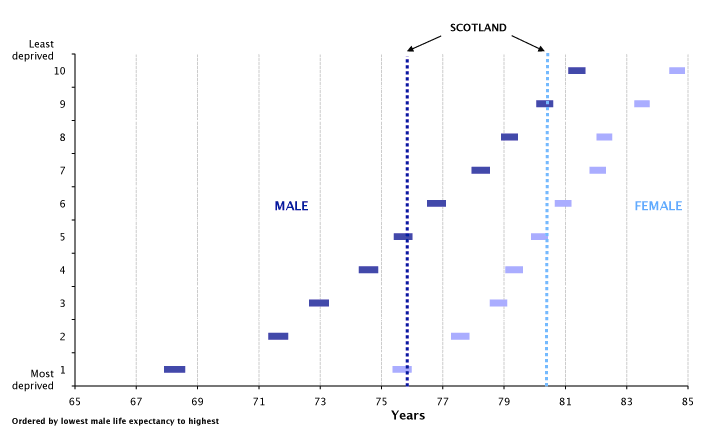
4.5.2 Male and female life expectancy increases as the level of deprivation decreases. Males in the 10 per cent least deprived areas of Scotland (decile 10) have a life expectancy at birth of 81.4 years, 13.2 years longer than in the 10 per cent most deprived areas, where male life expectancy is 68.2 years. Females in the 10 per cent least deprived areas can expect to live 84.6 years, 8.9 years longer than those in the 10 per cent most deprived areas, who can expect to live 75.7 years.
4.5.3 The gap between male and female life expectancy tends to decrease as the level of deprivation decreases. Female life expectancy is higher by 7.5 years in the 10 per cent most deprived areas and by 3.2 years in the 10 per cent least deprived areas. The gap is at its narrowest in decile 8 (3.1 years).